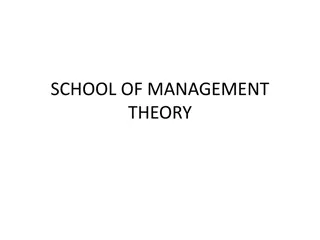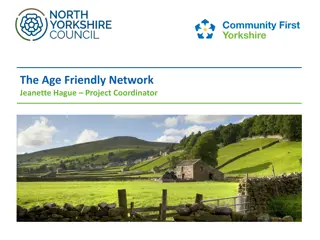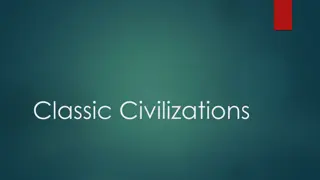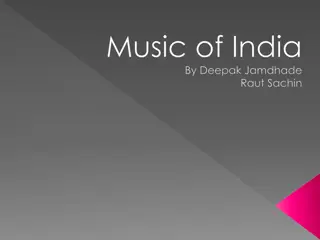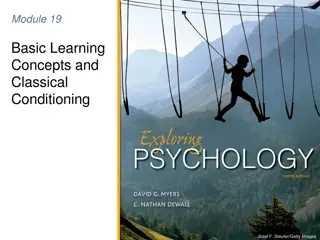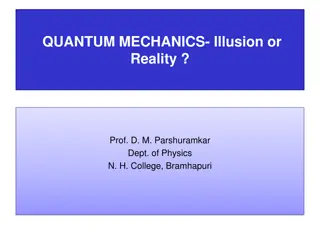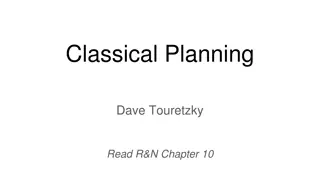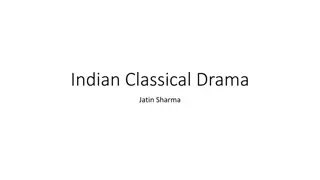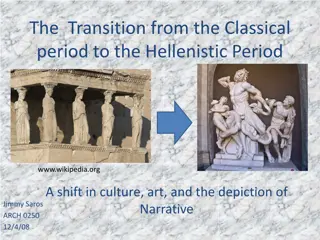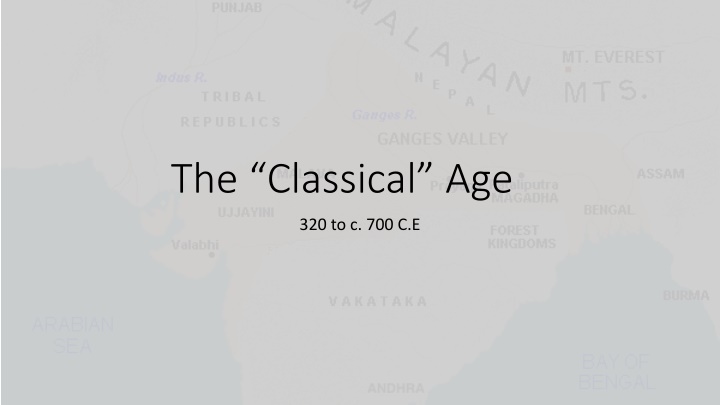
Gupta Empire and Beyond: India's Classical Age
Explore the Classical Age of India, highlighting the Gupta Empire's political overview, economic prosperity, and cultural developments. Discover the significance of other dynasties like the Vakatakas, Chalukyas, and Pallavas in shaping India's rich history during this period.
Download Presentation

Please find below an Image/Link to download the presentation.
The content on the website is provided AS IS for your information and personal use only. It may not be sold, licensed, or shared on other websites without obtaining consent from the author. If you encounter any issues during the download, it is possible that the publisher has removed the file from their server.
You are allowed to download the files provided on this website for personal or commercial use, subject to the condition that they are used lawfully. All files are the property of their respective owners.
The content on the website is provided AS IS for your information and personal use only. It may not be sold, licensed, or shared on other websites without obtaining consent from the author.
E N D
Presentation Transcript
The Classical Age 320 to c. 700 C.E
Our Focus Gupta Empire 320 to 470 CE North India centric bias to historiography But for 150 years between 320 to ca. 470 CE, Guptas provided peace, security, and prosperity. Periods of chaos both BEFORE and AFTER We have already seen series of invasions PRIOR to the Gupta period During and right after the GUPTAS came another set of C. Asian invaders, the HUNS Guptas provide a peaceful interlude, where trade, ideas, art, literature, etc., prospered. PLUS important developments in religion/culture/society So this period of peace, as it followed and was succeeded by an era of political turmoil in India, elevated to India's Golden AGE, or classical age New upstart dynasty, patronize BRAHMINS to acquire legitimacy Period of Brahmanical/ Vedic revival after being marginalized for almost half a millennium
Is the Classical Age only the Guptas? Major developments in arts, literature and religious ideas that give it the label of India s classical age But to associate only the GUPTAs with these developments remains a limited and North India-centric approach Contemporary VAKATAKA of C. India as important In Central and South India, a succession of ruling dynasties; some like the Chalukyas and the Pallavas making repeated comebacks Some of the greatest architectural wonders created by Rashtrakutas. In the Deccan and South, some of the greatest empires and the greatest cultural and artistic developments took place AFTER the Guptas We will return to look at peninsular India shortly
Gupta: Political Overview Chandragupta I (320-335) Samudragupta (335-375) Maximum territorial expansion. Consolidation by: Chandragupta II (Vikramaditya) (375-415) Kumaragupta (415-455) Skandagupta (455-467) Overall: Guptas expand the area under control of established kingdoms, bring forest-dwelling people under their control often with grants of UNCULTIVATED (forest) land to Brahmins BUT a pretty decentralized empire, lots of local Period of alliances (marital with Vakatakas) and conquests Read details in textbook, laid out pretty clearly
Gupta economy: building on history A period of great prosperity, evidenced by the Gupta gold coins Trade crucial, but trade and guilds had become imp. by the late Mauryan period, and had continued to prosper KUSHAN era with connections to global trade (see earlier lecture), critical in this regard Important families of SHRESHTHI or SETHS, came to dominate in Gupta era, offer credit, often at high interest rates. Rich enough to even offer loans to Kings
Science The Gupta era sees some important developments in SCIENCE, particularly Mathematics and Astronomy Approximation of Pi, theory of a heliocentric universe, theoretical measurements of the circumference of the earth, among others Gupta India was arguably the center of the scientific world at this time ARYABHATTA and VARAMIHIRA in Math/Astronomy. Susruta in medicine, surgery Metallurgy: construction of a 35 meter Iron pillar in present-day Delhi. Never rusted, from 400 CE to present
ARTS and ARCHITECTURE LITERATURE: Guptas patronize Kalidasa, acknowledged as one of the greatest poets and playwrights of all time. We will be discussing his SAKUNTALA in more detail soon. Also plays such as the Little Clay Cart Works on Human relationships such as the KAMA SUTRA Amazing developments in sculpture, MATHURA school of art. Plus GANDHARA But architecturally poor, few temples, though amazing carving Some of the best architecture, temples particularly, came AFTER the Guptas, in the so-called dark age of Indian history (which was only so if we focus only on NORTH). Dynasties in central and south emerge as major players after the Guptas, and also patronize many important temples
RELIGION: What is Hindu One reason why the Guptas considered a golden age is because much of what we understand as Hinduism emerge in this period. A series of texts called PURANAS critical to this enterprise BUT: What is Hinduism? - any ISM suffix mostly a 19th C coinage The term HINDU is not used a descriptor of a what we would recognize as RELIGION till very late, perhaps even as late as 16thC first used by GREEKS to describe the land beyond the river INDUS in 6th century BCE INDUS was known as SINDHU to the Vedic people and trans-SINDHU (beyond the river SINDHU) was corrupted to HINDU So HINDU was initially a term of GEOGRAPHY, that came to applied to ALL PEOPLE who lived across the INDUS
Hindus before Hindu Across the river Indus, people had a variety of social and religious practices Other than Vedic peoples, there were PRE-VEDIC peoples. DASAS and distinct from them, forest dwellers (whose protectors were the RAKSHASA) with own social and religious practices Some amount of assimilation, for instance noted in the MBH and other texts of the time ONE of the ways non-Vedic people INCORPORATED into the world and society of the Vedic rulers was by being assigned a place in the CASTE or VARNA hierarchy The more powerful people among the non-vedic people (e.g. TRIBAL chieftains) given a HIGH varna status, as KSHATRIYA, while the lower orders were incorporated at a lower level, e.g. as SUDRAS. Will return to VARNA a little later But this did not necessarily change the way people worshipped, so we have a variety of forms of worship, hundreds of gods, among people who use a mix of Vedic and local gods in worship. Vedas too, mention many gods, starting with the ones who were important early on AGNI, INDRA etc., later others seem to occupy an important place
Competing ideas of worship MANY and competing forms of WORSHIP, even AMONGST the Vedic people. Early VEDIC = fire, animals/ resourcs sacrificed to please the gods. But early on (c. 800 BCE) there were challenges to such forms of worship, from the writers of the UPANISHADS, who thought that KNOWLEDGE was the path to salvation, and rituals relatively meaningless In later centuries there were further challenges to the supremacy of the Brahmins, from HETERODOX preachers like BUDHHA and MAHAVIRA It is in the context of all of this that we need to recognize the SIGNIFICANCE of the series of TEXTS called the PURANAS that were COMPLETED in the Gupta era. PURANAS became the major vehicle of the incorporation of non-Vedic ideas, practices, and gods into a religio-social system that was dominated by the BRAHMINS
PURANAS The Puranas were legends about gods LINKING popular deities of the time to the figures mentioned in the VEDAS E.g. the VISHNU PURANA popularized the idea of VISHNU as savior, coming to earth in different incarnations, called AVATARS (yes, that s the origin of your online avatars!) to destroy those who threaten DHARMA. So far 9 avatars: MATSYA fish, KURMA tortoise, BOAR varaha, man Lion NARASIMHA, Dwarf VAMANA, PARASHURAMA, RAMA, KRISHNA, and BUDDHA. The final one, KALKI to come. Buddha incorporated to retrieve those who moved to Buddhism PURANAS, complicated legends, massive in size and scope, but could incorporate, for instance, local ANIMIST practices, to a VEDIC deity KRISHNA described as dark-skinned god, probably of pre-Vedic origin, probably incorporated into the MBH story AFTER the Gupta era, because it made so many references to KRISHNA as an AVATAR of VISHNU In the South, but also in less Aryan-ized parts of the North -- SHIVA, became an important deity through the PURANAS Shiva, also represented as dark colored, as an acetic decorated with snakes, often dirty, even the consumer of unclean polluting objects was also probably a way of incorporating pre-Aryan, or non-Aryan deities within the Aryan-Brahmanical framework SHIVA and VISHNU, along with another figure, BRAHMA (the creator) now incorporated as the TRINITY the three primary figures in the HINDU pantheon.
BHAKTI Puranas (and texts like the Bhagwat Gita, probably incorporated into MBH in the Gupta period), allow for the growth of NEW FORM OF DEVOTIONAL WORSHIP or BHAKTI So far there were TWO traditions of worship 1. Sacrificial kind, get Brahmins the ritual experts to conduct sacrifices, and assure salvation, or whatever desire 2. The so called KNOWLEDGE PATH of the Upanishads, a much more intellectual/philosophical outlook (Heterodoxies draw on this tradition greatly) With PURANIC literature, new kind of worship: devotion. One example in Krishna s advice to Arjuna in the MBH, that says the path to salvation not through sacrifices, not even through meditation and knowledge, but devotion, BHAKTI Cults of worship, centering around Vishnu or Shiva, or specific incarnations of Vishnu like Krishna became important during or soon after the Gupta period. Temples with images of deities emerged in this period -- possibly influenced by MAHAYANA forms of Buddhism that involved worship of images of the BODDHISATVA Earliest temples, with prayers date from Gutpa period, as does the practice of offering "puja" individual worship at temples or to images of a deity
Classical India Another field in which important new developments took place, was Hindu philosophy. Yoga, as well as the 5 other major "schools" of philosophy were systematized during the classical age." Thus, the characterization of the Gupta period as India's classical age, as much because of its literary and artistic developments as because some very important developments in devotion, worship and philosophy are traceable to this period These developments enabled Vedic religion to be transformed into a more coherent tradition which incorporated, and at the same time was able to influence, the religious practices of a large number of people in India and come close to what might be described as Hinduism"
Addendum Two of the developments which have to figure in any genealogy of Hinduism however, took place after the Guptas Both originated not in the so-called Hindu heartland of the North, but in the South BHAKTI or devotional worship was only formed the pre-history of very important Bhakti movements in the 15th and 16th Centuries, that we will return to later in the course The other, was the adoption of "VEDANTA" school of philosophy by a man named SHANKARA Vedanta drew upon ideas of the Upanishads, and was systematized along with Yoga and four other major philosphical "schools" in the Gupta era In the 8th and 9th Cs SHANKARA one of the most important advocates of Vedanta, travelled across the length and breadth of India, propagating this philosophy and held public disputations with the leading Hindu and Buddhist philosophers Shankara also set up institutions for propagating Vedantic Hinduism in four major centres in the N, S W and E India At a time when Buddhism was gaining ground at the expense of Hindu practices, Shankara is credited with reviving a "true" monistic "Hinduism." Shankara, and Vedanta, created the first Hindu revival" It is interesting that some of the Hindu revivalists of the 19th C also found their source of spirtuaa strength in the Vedanta



